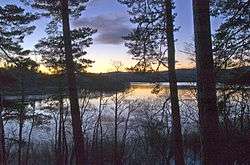Loch Davan
| Loch Davan | |
|---|---|
 Dawn at Loch Davan | |
| Location | Grampian, Scotland |
| Coordinates | 57°5′40″N 2°55′23″W / 57.09444°N 2.92306°WCoordinates: 57°5′40″N 2°55′23″W / 57.09444°N 2.92306°W[1] |
| Type | freshwater loch |
| Primary inflows | Red Burn and Logie Burn[2] |
| Primary outflows | Monandavan Burn [2] |
| Basin countries | Scotland |
| Max. length | 0.75 mi (1.21 km)[3] |
| Max. width | 0.33 mi (0.53 km)[3] |
| Surface area | 42.2 ha (104 acres)[1] |
| Average depth | 4 ft (1.2 m)[3] |
| Max. depth | 9 ft (2.7 m)[3] |
| Water volume | 25,000,000 cu ft (710,000 m3)[3] |
| Shore length1 | 3.3 km (2.1 mi)[1] |
| Surface elevation | 167 m (548 ft)[1] |
| Islands | 0[1] |
| 1 Shore length is not a well-defined measure. | |
Loch Davan is a small, triangular, freshwater loch approximately 5 mi (8.0 km) northeast of Ballater, Scotland and lying immediately north of Loch Kinord. It is approximately 0.75 mi (1.21 km) in length and was formed from a glacial kettle hole.[2][4] The loch sits within the Muir of Dinnet National Nature Reserve.[2]
Flora and fauna
Due to its shallowness, light penetrates to the loch floor. Consequently, many species of aquatic plants exist including water lobelia, quillwort and shoreweed. Around the perimeter reeds, sedges, horsetails, bulrushes and willow scrub are found. The loch is also home to pike, otters, migrating geese and other wildfowl.[2]
Archaeology
The remains of a medieval moated homestead, known as The Heugh are visible on the northern shore of the loch. The Heugh is thought to have been the Hall of Logy Rothwayne, the headquarters of Andrew de Moray during the Battle of Culblean in 1335.[2][5]
Survey
The loch was surveyed[3] on 10 July 1905 by T.N. Johnston and L.W. Collett and later charted [6] as part of the Sir John Murray's Bathymetrical Survey of Fresh-Water Lochs of Scotland 1897-1909.
References
- 1 2 3 4 5 "Loch Davan". British lakes. British Lakes. Retrieved 2 January 2015.
- 1 2 3 4 5 6 "The story of Muir of Dinnet National Nature Reserve" (PDF). Scotland's National Nature Reserves. Retrieved 2 January 2015.
- 1 2 3 4 5 6 "Bathymetrical Survey of the Fresh-Water Lochs of Scotland, 1897-1909, Lochs of the Dee (Aberdeen) Basin". National Library of Scotland. Retrieved 2 January 2015.
- ↑ "Davan, Loch". Gazetteer of Scotland. Retrieved 2 January 2015.
- ↑ "Aberdeenshire SMR - NJ40SW0014 - HEUGH, LOCH DAVAN". Aberdeen Council. Retrieved 2 January 2015.
- ↑ "Lochs Davan & Kinord (Vol. 5, Plate 54) - Bathymetrical Survey, 1897-1909 - National Library of Scotland". National Library of Scotland. Retrieved 2 January 2015.